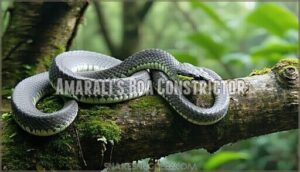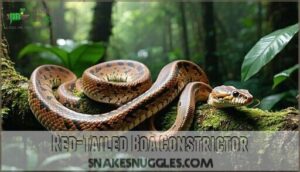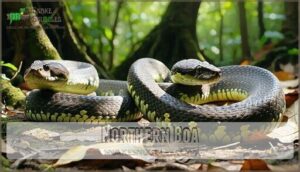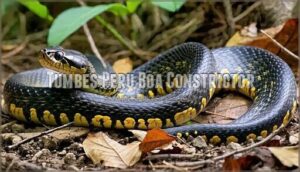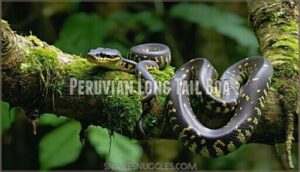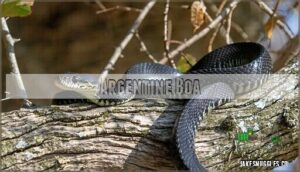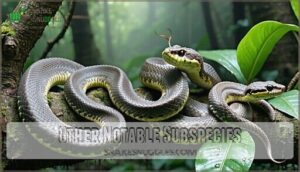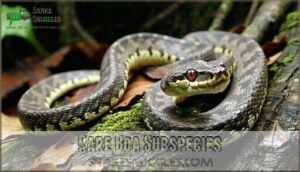This site is supported by our readers. We may earn a commission, at no cost to you, if you purchase through links.
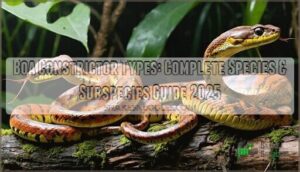 You’ll find three main boa constrictor types: Boa constrictor (true boa), Boa imperator (common boa), and Boa sigma (Mexican boa).
You’ll find three main boa constrictor types: Boa constrictor (true boa), Boa imperator (common boa), and Boa sigma (Mexican boa).
Within these species exist fascinating subspecies like the Red-Tailed Boa with its crimson patterns, the massive Argentine Boa reaching over 10 feet, and the golden-colored Tumbes Peru Boa.
Each type evolved unique traits for their specific habitats, from South American rainforests to Central American scrublands.
These differences matter whether you’re identifying wild specimens or choosing captive pets, and the diversity goes beyond basic species classifications—morphs, hybrids, and rare subspecies create an intricate world of patterns and characteristics that most people never realize exists.
Table Of Contents
- Key Takeaways
- Boa Constrictor Species
- Boa Subspecies Characteristics
- Boa Constrictor Types
- Boa Constrictor Hybrids
- Rare Boa Subspecies
- Frequently Asked Questions (FAQs)
- How many types of Boa constrictor are there?
- What is a boa constrictor?
- Is boa constrictor a red tailed boa?
- What do boa constrictors look like?
- Are Boas a constrictor snake?
- Are Boa constrictor Imperators docile?
- What is the most docile species of boa?
- What are the biggest boa constrictors?
- What is the best boa to own?
- How many boa constrictor species are there?
- Conclusion
Key Takeaways
- You’ll encounter three main species: Boa constrictor (true boa), Boa imperator (common boa), and Boa sigma (Mexican boa), each with distinct geographic ranges and physical characteristics that help with identification.
- Size varies dramatically by subspecies: You can expect Red-tailed Boas to reach up to 14 feet, while dwarf island morphs like Boa sigma stay around 3-4 feet, making size a key identifier.
- Geographic location determines traits: You’ll find that each subspecies has evolved specific adaptations—Argentine boas developed robust builds for grasslands, while Peruvian long-tail boas gained enhanced arboreal abilities for forest canopies.
- Conservation status ranges from stable to critical: You need to know that Argentine boas are CITES Appendix I listed due to habitat loss, while common boas maintain stable populations, affecting availability and legal ownership requirements.
Boa Constrictor Species
You’ll encounter three primary boa constrictor species that form the foundation of this diverse snake family.
These species include Boa constrictor, Boa imperator, and Boa sigma, each with distinct characteristics and geographic distributions that help scientists classify the many subspecies you’ll discover.
Boa Constrictor
These powerful constrictors rule their territories through impressive boa anatomy and refined constriction mechanics.
You’ll find Boa constrictor species showcase remarkable boa evolution adaptations across South America’s diverse landscapes.
Essential characteristics include:
- Size Range: Adults reach 8-10 feet with robust, muscular builds
- Hunting Strategy: Ambush predators using powerful coiling techniques
- Captive Care Requirements:** Moderate temperatures, spacious enclosures needed
- Distinctive Features: Bold saddle patterns distinguish them from Boa imperator relatives
Boa Imperator
Across Central America’s lush landscapes, Boa imperator stands apart as a distinct species with remarkable habitat variation.
You’ll find these adaptable constrictors thriving from Mexican dry forests to Colombian rainforests. Their temperament differences make them ideal for captive breeding programs, while regional morphs showcase stunning diversity.
The species, also known as the Emperor Boa, exhibits a light brown dorsal coloration. Despite stable conservation status, some populations face pressure from habitat loss.
| Characteristic | Mainland Variations | Island Morphs |
|---|---|---|
| Size | 6-8 feet average | Dwarf boas 4-5 feet |
| Coloration | Brown/tan patterns | Hypomelanistic pink/orange |
| Temperament | Generally docile | Extremely calm |
| Habitat | Diverse ecosystems | Limited island ranges |
| Breeding | Widespread programs | Specialized collections |
Boa Sigma
Discovering Boa sigma reveals one of the most genetically distinct subspecies among boa constrictor types.
You’ll find this elusive snake along Mexico’s Pacific Coast, where Sigma Habitat includes tropical dry forests facing serious conservation threats.
The smallest of boas, the Boa sigma often measures no more than 3 feet.
Sigma Genetics shows remarkable genetic divergence from other subspecies, making Sigma Identification essential for researchers.
Here’s what makes this subspecies unique:
- Sigma Behavior mirrors typical ambush tactics but adapts to drier environments
- Intricate patterns provide exceptional camouflage in their specific habitat
- Limited distribution makes every individual important for species survival
Sigma Conservation efforts focus on protecting remaining forest patches, as habitat destruction threatens this remarkable subspecies’ future.
Boa Subspecies Characteristics
You’ll find four primary boa constrictor subspecies that showcase remarkable diversity in size, coloration, and habitat preferences.
Each subspecies has evolved unique characteristics that reflect their specific geographic regions and environmental conditions.
Amarali’s Boa Constrictor
The Amarali’s boa stands out among boa constrictor types with its distinctive short-tail adaptation and silvery-grey complexion.
These muscular constrictors showcase nature’s artistry through distinctive patterns and remarkable regional adaptations.
You’ll find this stocky subspecies thriving in Bolivian habitat and Brazilian habitat, where its robust build perfectly suits diverse environments.
Unlike the Argentine boa, Amarali’s displays uniquely defined saddle patterns that make identification straightforward for enthusiasts exploring different boa subspecies.
Mature females typically reach lengths where size is an identifier.
Red-Tailed Boa Constrictor
The redtailed boa commands attention with its signature copper-red tail patterns contrasting against tan bodies marked by dark saddles.
This BCC (Boa constrictor constrictor) thrives across South American natural habitat, from rainforests to savannas, making it adaptable for captive breeding programs.
As nocturnal ambush predators, they hunt birds, mammals, and small reptiles.
Here’s what makes these Boa constrictor types special:
- Striking red-tail size reaches up to 14 feet, creating an impressive display
- Gentle temperament traits make them ideal for experienced handlers seeking control
- Vibrant color morphs showcase nature’s artistic power in every pattern
- Robust build differs distinctly from the smaller boa imperator
- Nocturnal hunting prowess demonstrates their wild heritage and instinctive behavior
Northern Boa
You’ll find Northern Boas across habitat regions from Mexico to Central America, displaying remarkable physical variations in their tube-like, muscular bodies.
Their mild temperament traits make them excellent for captive care, while their blunt heads distinguish them from other boa constrictor types.
These mainland variations maintain stable conservation status through effective nocturnal hunting strategies.
Tumbes Peru Boa Constrictor
When you encounter the Tumbes Peru Boa Constrictor (Boa constrictor longicauda), you’ll notice its distinctive spearhead markings and contrasting black-and-gold coloration.
This Peruvian endemic showcases unique adaptations through genetic isolation, with females averaging 6.5 feet.
Unfortunately, its conservation status remains concerning due to habitat specificity requirements.
Understanding this subspecies helps clarify boa constrictor species taxonomy within the broader boa constrictor complex.
Boa Constrictor Types
When you’re exploring boa constrictor types, you’ll discover fascinating variations that go beyond the basic species classifications.
These distinct types showcase remarkable adaptations to specific geographic regions and environmental conditions, from the impressive Argentine boa’s robust build to the unique proportions of Peruvian long tail boas.
Peruvian Long Tail Boa
You’ll discover the Peruvian longtail boa stands out among boa constrictor types with its distinctive spearhead markings and exceptional tail length.
This subspecies from Peru’s Tumbes region showcases unique adaptations including enhanced arboreal behavior that sets it apart from other morphs.
Its striking black-and-gold patterns make identification straightforward, though its vulnerable status demands careful conservation attention.
Wild populations face mounting pressure from habitat destruction, making captive breeding programs increasingly important for preserving this remarkable subspecies’ genetic diversity and distinctive taxonomy.
These boas are one of the three main species.
Argentine Boa
The Argentine boa (Boa constrictor occidentalis) represents South America’s most threatened subspecies.
Argentina’s gentle giants face extinction as forests disappear and illegal collectors threaten their survival.
You’ll find this heavy-bodied snake throughout Argentina’s northern regions, where habitat loss continues shrinking its geographic range.
Their darker coloration helps distinguish them from other subspecies, while their conservation status demands immediate attention.
These snakes sometimes need specialized care products to thrive.
Here’s what makes Argentine boas remarkable:
- CITES Listing: They’re the only boa subspecies on Appendix I due to declining populations
- Geographic Distribution: Limited to Argentina’s dry forests and grasslands, making them vulnerable
- Habitat Requirements: These morphs need specific temperature gradients that captive breeding programs carefully replicate
Their muscular build and calm temperament make them fascinating, though their near-threatened status means responsible ownership matters more than ever.
Other Notable Subspecies
Beyond the Argentine boa, several remarkable subspecies demonstrate nature’s creative power.
Boa imperator dominates Central America with stunning color morphs, while island boas like the Dominican clouded boa showcase unique adaptations.
Dwarf boas from specific localities display compact builds and pattern variations.
These subspecies highlight evolutionary specialization across diverse habitats.
| Subspecies | Notable Features |
|---|---|
| Dominican Clouded (nebulosa) | Gray-brown coloration, highly arboreal |
| Orton’s Boa (ortonii) | Cold-tolerant, mountain dweller |
| St. Lucia Boa | Protected species, endemic island form |
| Pearl Island Boa | Isolated population, unique genetics |
| Mexican Coastal | Pacific adaptation, smaller size |
Future research continues revealing new insights about these Tumbes Peru Boa Constrictor populations and their relationships.
Boa Constrictor Hybrids
You’ll encounter hybrid boas when different subspecies interbreed in overlapping geographic ranges or through selective captive breeding programs.
These hybrids display unique combinations of color patterns, body proportions, and behavioral traits that blend characteristics from their parent subspecies.
Hybrid Localities
Crossing regional boa populations creates hybrid localities that blend distinct geographic traits.
When you breed Suriname boas with Colombian specimens, you’ll get offspring combining South American size with Central American coloration patterns.
These genetic mixing events produce interbreeding zones where morphs showcase varied characteristics—some hybrids reach only 4-5 feet while displaying enhanced reds.
These hybrids are sometimes created because Central American boas are popular pets.
Though hybrid origins offer fascinating morph variations and genetic diversity, this interbreeding threatens pure bloodlines and creates conservation impact concerns for maintaining authentic locality specimens.
Color and Pattern Morphs
When you breed hybrid boas, morph genetics create stunning color and pattern morphs.
Selective breeding combines genes like hypo-leopard or albino-motley, producing unique boa constrictor colors and boa constrictor patterns.
Fire morphs enhance color intensity, while pattern aberrations create cryptic designs.
These boa morphs showcase genetic artistry, with new morphs emerging through multi-generational breeding programs that blend desirable traits into designer specimens.
Boa breeders often research boa morph genetics to understand potential outcomes.
Rare Boa Subspecies
Several boa subspecies face significant conservation challenges, with some teetering on the edge of extinction due to habitat destruction and illegal collection.
You’ll find that subspecies like the Argentine boa and St. Lucia boa require immediate protection through captive breeding programs, habitat restoration, and strict enforcement of international trade regulations.
Threats to Rare Subspecies
Five major threats devastate rare boa populations worldwide.
Habitat loss from deforestation eliminates up to 80% of suitable environments, while illegal trade targets endangered species for the pet market.
Climate change disrupts breeding cycles and prey availability, reducing genetic diversity in isolated populations.
Invasive species and human persecution compound these pressures.
Without immediate conservation efforts and CITES appendix 1 protections, these threatened species face extinction within decades.
Conservation Efforts
Protecting endangered boa subspecies requires coordinated global action.
While habitat loss threatens their survival, thorough conservation efforts offer hope through strategic interventions:
- Captive Breeding programs maintain genetic diversity while wild populations recover
- CITES restrictions control international trade and prevent over-collection
- Habitat Protection preserves critical limestone forests and cave systems
- Public Education dispels myths and builds community support
- Genetic Research guides reintroduction protocols and population management
These conservation efforts work together, creating safety nets that’ll keep rare boas from disappearing forever.
Habitat Preservation and Restoration
Across South America’s fragmented landscapes, habitat preservation requires strategic action.
Reforestation efforts create essential habitat corridors linking isolated populations, while protected areas shield endangered subspecies from habitat loss.
Climate resilience planning addresses changing conditions threatening boa survival.
Community involvement empowers locals through education programs, making conservation efforts sustainable and effective long-term.
Frequently Asked Questions (FAQs)
How many types of Boa constrictor are there?
You’ll find ten recognized subspecies of boa constrictors, including Red-tailed, Northern, Amarali’s, Argentine, and Dominican Clouded boas. Each subspecies varies in size, coloration, and habitat preferences across the Americas.
What is a boa constrictor?
With lifespans reaching 40 years, you’ll find boa constrictors are non-venomous snakes that kill prey by constriction. They’re semi-arboreal hunters from the Americas, giving birth to live young.
Is boa constrictor a red tailed boa?
You’re thinking of the red-tailed boa, which is actually a subspecies of boa constrictor called Boa constrictor constrictor. It’s one of ten recognized subspecies within the broader boa constrictor family.
What do boa constrictors look like?
You’ll recognize boa constrictors by their robust, muscular bodies reaching 6-10 feet long.
They display beautiful patterns of brown, tan, and cream saddle markings across their backs with distinctive triangular heads.
Are Boas a constrictor snake?
With over 10 recognized subspecies spanning the Americas, you’ll find that boas are indeed powerful constrictors.
They kill prey by wrapping around and squeezing, disrupting circulation rather than crushing bones like you might expect, which showcases their unique method of constriction as constrictors.
Are Boa constrictor Imperators docile?
Yes, you’ll find Boa constrictor imperators are generally docile and calm-natured snakes.
They’re known for their mild temperament, making them popular pets.
However, individual personalities can vary, and proper handling techniques remain essential for safety.
What is the most docile species of boa?
In the process of choosing your slithery sidekick, you’ll find the Northern Boa (Boa constrictor imperator) typically offers the most docile temperament among boa species, making them excellent beginner-friendly companions.
What are the biggest boa constrictors?
You’ll find Red-tailed Boas reaching up to 9 feet, while Argentine Boas can stretch to 10 feet. Some exceptional specimens hit 13 feet, making them true giants among constrictors.
What is the best boa to own?
Bold boa beginners benefit from Common Boas (Boa imperator). You’ll find they’re docile, manageable at 6-8 feet, and adapt well to captivity with proper care, heating, and handling.
How many boa constrictor species are there?
Currently, you’ll find two main boa constrictor species: Boa constrictor and Boa imperator. However, taxonomists recognize at least ten subspecies within these groups, creating ongoing debates about exact classification numbers.
Conclusion
Exploring the intricate world of boa constrictor types reveals nature’s remarkable adaptability in action.
From the massive Argentine boas stretching across South American plains to the golden Tumbes Peru specimens thriving in coastal regions, you’ve discovered how geography shapes these magnificent serpents.
Understanding these distinctions helps you appreciate the complexity beyond simple species labels, and recognizing the differences between true boas, common boas, and their various subspecies enriches your knowledge of these fascinating constrictors.
Whether you’re identifying wild populations, selecting captive specimens, or supporting conservation efforts, this understanding is crucial for a deeper appreciation of boa constrictors.
- https://en.wikipedia.org/wiki/List_of_boine_species_and_subspecies
- https://animaldiversity.org/accounts/Boa_constrictor/
- https://amphibian-pug-rzk5.squarespace.com/s/BoaConstrictors.pdf
- https://www.reddit.com/r/BoaConstrictors/comments/1dy5xb2/whats_the_difference_between/
- https://www.britannica.com/animal/boa-constrictor

